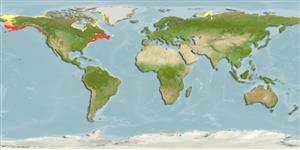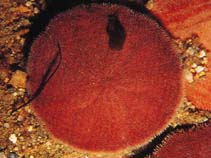Echinarachnius parma (Lamarck, 1816)
Purple sand dollar| Native range | All suitable habitat | Point map | Year 2050 |

|
| This map was computer-generated and has not yet been reviewed. |
| Echinarachnius parma AquaMaps Data sources: GBIF OBIS |
Классификация / Names народные названия | синонимы | CoL | ITIS | WoRMS
Echinoidea | Echinolampadacea | Echinarachniidae
Environment: milieu / climate zone / пределы глубины / distribution range экология
; пределы глубины 0 - 150 m (ссылка 95072). Polar
Distribution страны | регионы FAO | Ecosystems | места находок | интродукции
Arctic, Northern Pacific and Northern Atlantic. Polar to subtropical.
Length at first maturity / Size / Weight / Возраст
половая зрелость: Lm ? range ? - ? cm
Life cycle and mating behavior половая зрелость | размножение | нерест | Eggs | Fecundity | Larvae
Основная ссылка
ссылки | координатор | соавторы
Austin, W.C. 1999 Rare and endangered marine invertebrates in British Columbia. Proc. Biology and Management of Species and Habitats at Risk, Kamloops, B. C., 15-19, Feb 1999. (ссылка 1306)
Статус Красного Списка МСОП
(ссылка 130435: Version 2025-1)
Статус СИТЕС (ссылка 108899)
CMS (ссылка 116361)
Угроза для людей
Использование человеком
| FishSource |
инструменты
дополнительная информация
ресурсы в Интернет
BHL | BOLD Systems | CISTI | DiscoverLife | FAO(Publication : search) | Fishipedia | GenBank (Геном, Нуклеотид) | GloBI | Gomexsi | Google Books | Google Scholar | Google | PubMed | Tree of Life | Wikipedia (Вперёд, поиск) | Zoological Record



